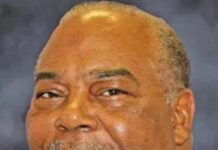 A University of Arkansas at Little Rock professor and alumnus have uncovered new information regarding the Elaine Massacre, one of the worst race massacres in United States history.
A University of Arkansas at Little Rock professor and alumnus have uncovered new information regarding the Elaine Massacre, one of the worst race massacres in United States history.
Almost exactly 100 years ago, in September 1919, representatives of the Progressive Farmers and Household Union of American met with approximately 100 African-American farmers at a church in Hoop Spur, near Elaine, Arkansas, to discuss unionizing. The meeting was interrupted by a group of White men who shot and killed two other White men in the meeting. Then, a mob of about 500 to 1,000 White people stormed through Phillips County, Arkansas, killing Black men, women, and children on sight. As a result, U.S. troops were called in, and the mob dispersed on October 2, 1919. It is estimated that between 100 and 237 African Americans were killed during the riot.
Recently, Joseph Alley, a 2016 graduate of the University of Arkansas at Little Rock and curator of the Helena Museum of Phillips County, discovered a book at American Legion Post 41 in Helena. The book has entries from the post’s inception in 1919 through 1925.
“Dr. Brian Mitchell (assistant professor of history at the University of Arkansas at Little Rock) and I were talking after the Elaine Massacre Conference held at the Mosaic Templars Cultural Center on June 1,” Alley said. “He mentioned some of the documents he was still trying to find, and I mentioned we have all of the Women’s Library Association’s original ledgers from 1888 and on. This was the group that founded the Phillips County Library and Museum. As I was initially going through them, there was one book labeled ‘American Legion.’ Low and behold, it was the 1919 minute book ledger.”
Under an entry titled “POST IN ACTION,” the minute book described the actions of local American Legion members in the midst of the Elaine Massacre on October 1, 2019: “Members of the Post were summoned to the Court House as a result of the Assassination of a Special Agent. . . . They were among the first to arrive on the scene of the murder and in the subsequent fighting negro rioters.”
Two members of the American Legion and World War I veterans, James A. Tappan and Clinton Lee, died during the Elaine Massacre. The legion adopted the “Resolutions of Respect to the Memory of James A. Tappan and Clinton Lee,” on October 14, 1919. The two men were honored as war heroes and added to a memorial plaque of American Legion members killed during World War I, despite the fact that they did not die during the war.
The resolutions state, “There has been an insurrection of Negroes in Phillips County, and the lives and property of our citizens have been placed in jeopardy.” The resolutions further say that Tappan and Lee were killed “while in the line of duty. In preserving law and order and defending the lives and property of our fellow citizens from attacks by Negro insurrections.”
Following the Elaine Massacre, hundreds of African Americans were arrested and convicted in questionable trials by all-White juries. The most notorious was a group called the Elaine 12, a dozen Black sharecroppers who were convicted of murder and sentenced to death. According to the new research, members of the American Legion were highly motivated to ensure that Black men arrested after the massacre received the death penalty in order to send a message to the remaining sharecroppers.
“The minute book talks about the contacts they make with the governor and their demands to be part of the investigation,” Dr. Mitchell said. “The same people who were in the mob that hunted down people during the massacre then made demands on the governor that the men would be given the death penalty. They wanted the death penalty because they wanted to send an example for other sharecroppers that might consider legal action against them for stealing their wages. This further substantiates the Supreme Court’s ruling in Moore v. Dempsey that these individuals did not receive a fair trial.”
Dr. Mitchell plans to study the records and include the information in a book he is co-authoring with Dr. Guy Lancaster, editor of the Encyclopedia of Arkansas History and Culture, and Dr. Grif Stockley, author of Blood in Their Eyes: The Elaine Race Massacre of 1919 (University of Arkansas Press, 2001). He believes records like the minute book are significant because they show a history of those who were directly involved in the massacre and show some of the motivations behind their actions.
“Just like these documents appeared out of nowhere, who knows what will pop up?” Dr. Mitchell said. “That is why it is so important for us to look at journals, letters, and other historical documents that can tell us more about the Elaine Massacre.”
The minute book is considered too fragile and therefore will not be on display at the Helena Museum. However, a digital copy will be made available for the public through the Arkansas State Archives at the end of the summer.











Hate is still prevalent in the community. Phillips county has a lot of healing to do.